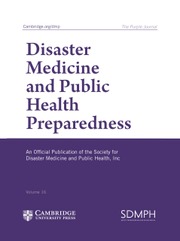Natural disasters in the US have resulted in persistent morbidity and mortality due to disruptions in access to health care, loss of critical utilities, and displacement, disproportionately affecting disadvantaged communities. Among natural disasters, wildfires are frequently associated with unplanned power outages from infrastructure damage or planned outages aiming to de-energize powerlines in anticipation of wildfires. The planned outages – public safety power shutoffs (PSPS) – are deployed to protect life and property.Reference Huang, Hu and Sang1 Power outages particularly impact the medically vulnerable, precluding the use of electricity-dependent equipment like nebulizer machines and wound vacs, affecting refrigeration of medications, or simply shutting down fans and air conditioning.Reference Do, McBrien and Flores2
The 2019 fire season was devastating, and its largest fire, the Kincade Fire, was caused by electrical transmission lines despite the extended, deliberate outages across the state. We calculated county-level cumulative exposure to power outages in 2019. More customers experienced PSPS events in 2019 alone than in 2020-2023 combined, and power outages caused extended disruptions in nearly every California county (Supplement A–C). More than half the events in October 2019 lasted more than 24 hours. Many Medicare beneficiaries were Durable Medical Equipment (DME) users in counties where disruptions lasted longer than 24 hours. Counties at the highest risk for significant power disruptions were home to many at-risk populations, including DME users and those with limited health care access (Supplement D, E).
Since 2019, governmental, nongovernmental, and health care organizations have significantly invested in decreasing necessary de-energizing events and mitigating their negative impacts.Reference Wong, Broader and Shaheen3 The California Department of Public Health and utility companies like PG&E have invested in microgridding efforts, portable battery programs, community resource centers, and increased public outreach and engagement, such as the Medical Baseline program for patients needing power to receive electricity services at lower rates. However, the results of a study of adults with access and functional needs in Mariposa County found significantly increased delays in medical care and health harms in those with more medical conditions or using more medical devices after the 2022 Oak Fire.Reference Wiskel4
We continue to prepare for disasters in the US by mostly preparing for mass casualty events. Our analysis underscores the need to integrate in situ medical vulnerability (to power disruptions or other interruptions in health care access) into disaster planning and response. The US sees more frequent, cascading crises, such as the compound climate disaster resulting in severe power outages during Hurricane Beryl and extreme heat in Texas in the summer of 2024. Pre-emptive planning should require mapping and maintaining rosters of medically vulnerable populations that can be reached in anticipation of disasters in the context of local hazards. Effective alternative pathways to health care access must be integrated into disaster response planning. Local capacity to access and use such data in decision-making is limited and requires local or federal investment expansion. Integrating high-resolution socioeconomic and medical vulnerability data, especially regarding those critically dependent on electricity and other care services, in disaster planning and response is a prudent and essential step in caring more equitably for communities impacted by disasters.Reference Balsari, Kiang and Buckee5
Supplementary material
The supplementary material for this article can be found at http://doi.org/10.1017/dmp.2025.46.
Author contribution
Conceptualization: SJ, SB; Data Curation & Analysis: SJ, AS; Funding Acquisition: CB, AS, SB; Project Administration: NSB, CB, AS, SB; Resource & Funding Acquisition: CB, AS, SB; Supervision: CB, AS, SB; Original Draft Preparation: NSB; Review & Editing: SJ, CB, AS, SB; Neil Singh Bedi BA and Shenyue Jia PhD contributed equally as first authors.


